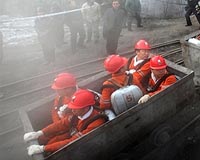| . |  |
. |
Xiangning, China (AFP) April 6, 2010 Rescuers were searching Tuesday for 32 workers still trapped in a flooded Chinese coal mine, as the joy of seeing over 100 others pulled out alive was tempered by the first news of fatalities. Six bodies have been recovered from the Wangjialing mine in Shanxi province, China's coal-producing heartland in the north but authorities insist there is still hope the rest will be found alive. "We now have six fatalities in the Wangjialing mining disaster and we have yet to find the 32 workers that are trapped," China News Service quoted Shanxi Governor Wang Jun as saying after the latest victim was found Tuesday afternoon. "We will do everything to rescue alive the 32 mine workers." On Monday, rescuers wept with joy as 115 workers were brought one by one from the pit -- some rare good news for an industry plagued by fatal accidents which last year killed more than 2,600 miners, according to government figures. Survivors have said they endured the eight days and nights of darkness by eating tree bark, sawdust, paper and even coal, while occasionally drinking the dirty water swirling around and below them. "Many of us collected paper floating on the water, put it in our pockets and ate it when we felt hungry," Xinhua news agency quoted one unidentified worker as saying. "Some even chewed the coal to quench the hunger," the man said in the Shanxi Aluminium Plant Hospital, as he tucked into a bowl of noodles. But as workers installed more pumps and other drainage equipment at the state-owned mine, with nurses at the ready to tend to eventual survivors, anxious relatives desperately sought news of their loved ones. "We don't know whether he is still trapped underground or in hospital," Yang Xiaolin, 45, said of his nephew, a 35-year-old electrician. "We've been to the hospital but they refuse to tell us if he is still trapped and they refuse to let us in," he told AFP. Hospitals where survivors were being treated turned away AFP journalists and even relatives seeking to see their loved ones. Xinhua quoted doctors saying it was for the patients' well-being. Officials also however seem keen to control information about the disaster after workers had earlier angrily accused the mine's owners of ignoring safety risks. About half of the survivors were taken to the provincial capital Taiyuan for treatment. A few relatives were lucky enough to have spoken to their loved ones. "I was so happy when I heard his voice. But I never thought he'd actually died," Lu Huidong, 28, told AFP in a hospital in the nearby city of Hejin, where his 22-year-old brother was being treated after his ordeal. President Hu Jintao and Premier Wen Jiabao have urged all-out efforts to save the men still missing in the pit, which flooded on March 28 during construction work. But Liu warned that rescue work was getting more treacherous. Workers were feeling "extremely tired" with some falling ill, and the build-up of toxic gases was a serious problem -- with the risk of an explosion mounting. Among the survivors, 26 were in "relatively serious" condition, suffering from dehydration, malnutrition and skin infections from prolonged water exposure, Xinhua quoted doctors as saying. Xinhua quoted the survivor at the aluminium plant hospital saying he and colleagues built a wooden platform to stay above the water level. "More than 20 of us huddled on the platform to stay dry in the flooded pit. We also built rafts in the hope that we might row out, but we failed," he said. The accident occurred when workers apparently dug into an older adjacent mine that had been shut down and filled with water, a practice used to stabilise the geology in abandoned collieries, press reports have said. The national work safety watchdog blamed the accident on owner Huajin Coking Coal Company, which failed to heed repeated warnings that water was building up days before the disaster. Safety standards are widely flouted in China's mines in the quest for quick profits and to meet surging coal demand -- source of about 70 percent of the country's energy. Amid anger over mounting mining deaths, China in recent years touted a drive to shut unsafe mines, saying it had closed thousands, many in Shanxi. However, deadly mining disasters have remained a near-weekly occurrence.
Share This Article With Planet Earth
Related Links Surviving the Pits
 China hails 'miracle' as 115 rescued from flooded mine
China hails 'miracle' as 115 rescued from flooded mineXiangning, China (AFP) April 5, 2010 More than 110 workers were pulled out alive from a Chinese coal mine on Monday in what has been hailed as a miracle rescue over a week after the men were trapped by an underground flood. So far, 115 survivors have been rescued from the mine in China's coal-mining heartland of Shanxi province, state media said. Some apparently survived on tree bark and at least one worker strapped himself to ... read more |
|
| The content herein, unless otherwise known to be public domain, are Copyright 1995-2010 - SpaceDaily. AFP and UPI Wire Stories are copyright Agence France-Presse and United Press International. ESA Portal Reports are copyright European Space Agency. All NASA sourced material is public domain. Additional copyrights may apply in whole or part to other bona fide parties. Advertising does not imply endorsement,agreement or approval of any opinions, statements or information provided by SpaceDaily on any Web page published or hosted by SpaceDaily. Privacy Statement |